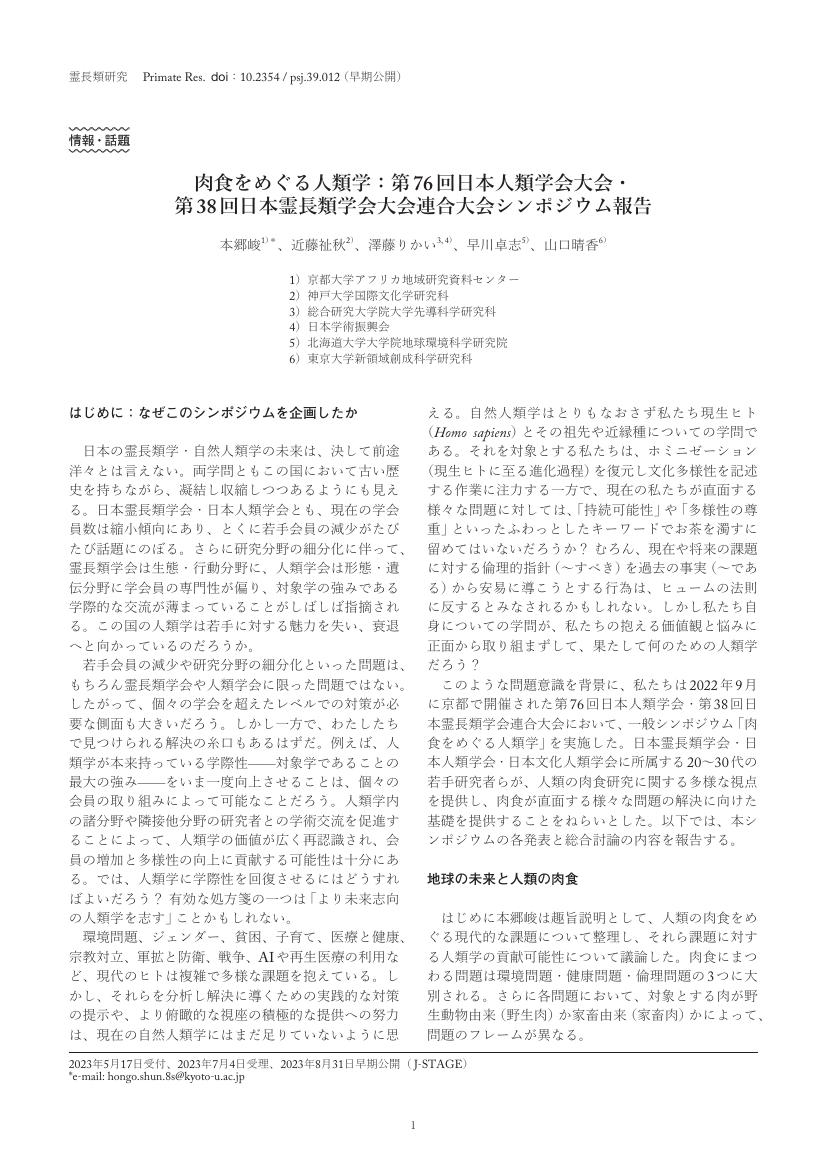5 0 0 0 OA 道路上の糞を探す踏査で明らかになった屋久島のニホンザルの全島分布(2017‐2018年)
- 著者
- 半谷 吾郎 好廣 眞一 YANG Danhe WONG Christopher Chai Thiam 岡 桃子 楊木 萌 佐藤 侑太郎 大坪 卓 櫻井 貴之 川田 美風 F. FAHRI SIWAN Elangkumaran Sagtia HAVERCAMP Kristin 余田 修助 GU Ningxin LOKHANDWALA Seema Sheesh 中野 勝光 瀧 雄渡 七五三木 環 本郷 峻 澤田 晶子 本田 剛章 栗原 洋介
- 出版者
- 一般社団法人 日本霊長類学会
- 雑誌
- 霊長類研究 (ISSN:09124047)
- 巻号頁・発行日
- pp.36.014, (Released:2020-11-30)
- 参考文献数
- 23
We studied the island-wide distribution of wild Japanese macaques in Yakushima (Macaca fuscata yakui) in May 2017 and 2018. We walked 165.4 km along roads and recorded the location of 842 macaque feces. We divided the roads into segments 50 m in length (N=3308) and analyzed the effect of the areas of farms and villages or conifer plantations around the segments and also the presence of hunting for pest control on the presence or absence of feces. We divided the island into three areas based on population trend changes over the past two decades: north and east (hunting present, population decreasing); south (hunting present, no change) and west (hunting absent, no change). According to conditional autoregressive models incorporating spatial autocorrelation, only farms and villages affected the presence of feces negatively in the island-wide data set. The effect of hunting on the presence of feces was present only in the north and east and the effect of conifer plantations was present only in the west. Qualitative comparisons of the census records from the 1990s with the more recent census indicated that feces were no longer found in the private land near the northern villages of Yakushima, where macaques were previously often detected in the 1990s. In other areas, such as near the southern villages or in the highlands, macaques were detected both in the 1990s and in 2017-2018. Our results further strengthen the possibility that the macaques have largely disappeared around the villages in the northern and eastern areas. Since the damage of crops by macaques has recently reduced considerably, we recommend reducing hunting pressure in the north and east areas and putting more effort into alternative measures such as the use of electric fences.
- 著者
- 本郷 峻 近藤 祉秋 澤藤 りかい 早川 卓志 山口 晴香
- 出版者
- 一般社団法人 日本霊長類学会
- 雑誌
- 霊長類研究 (ISSN:09124047)
- 巻号頁・発行日
- pp.39.012, (Released:2023-08-31)
- 参考文献数
- 15
- 著者
- 本郷 峻
- 出版者
- 一般社団法人 日本霊長類学会
- 雑誌
- 霊長類研究 (ISSN:09124047)
- 巻号頁・発行日
- vol.36, no.2, pp.73-74, 2020 (Released:2020-12-23)
- 著者
- 本郷 峻
- 出版者
- 一般社団法人 日本霊長類学会
- 雑誌
- 霊長類研究 (ISSN:09124047)
- 巻号頁・発行日
- pp.36.012, (Released:2020-11-26)
1 0 0 0 OA マンドリル(Mandrillus sphinx)の群れの分派と社会構造
- 著者
- 本郷 峻
- 出版者
- 日本霊長類学会
- 雑誌
- 霊長類研究 Supplement 第27回日本霊長類学会大会
- 巻号頁・発行日
- pp.6, 2011 (Released:2011-10-08)
アフリカ大陸中部の熱帯雨林林床に生息するマンドリルMandrillus sphinxは、最大800個体を超える群れが報告され、100 km2以上に及ぶ広大な遊動域を持つことで知られる。系統的には、one-male unitを単位とする重層社会を持つマントヒヒやゲラダヒヒを含む、ヒヒ亜族(Papionina)に分類される。これまでいくつかの野生群を対象とする報告がなされているものの、観察の困難さ・広い遊動域などの理由により研究は極めて遅れており、社会構造に関する統一された見解は得られていない。本発表では、野生マンドリルの集団個体数の変化や群れの社会構造に関する予備的な結果を報告し、彼らの食性の季節的変化との関連から考察する。 調査はガボン共和国・ムカラバ‐ドゥドゥ国立公園において、2009年8-11月と2010年1-6月の間、合計約7ヶ月間にわたり実施された。約30 km2の調査域において発見されたマンドリル集団の個体数を目視によりカウントするとともに、集団が調査路や川など開けたところを横切る際にビデオカメラで撮影し、群れの性・年齢構成と移動時の個体順序を分析した。また、通跡上の糞を採集して分析し、果実・葉・葉以外の繊維質・アリなど節足動物などの食物カテゴリー体積比から食性を推定した。 調査の結果、集中分布する果実を多く食べる時期の方が、繊維質や地表のアリ類といった高密度一様分布する食物を多く食べる時期に比べて、集団内でカウントされた個体数が有意に少ないことがわかった。また、しばしば集団が複数の小集団へ分派し、再び合流することも観察された。これらの結果は、マンドリルが各時期の主要食物の分布様式に対応して、分派と合流によって群れのまとまりの程度を変化させている可能性があることを示す。 さらに、集団に占めるオトナオス・ワカモノオス(推定6歳以上)の割合は、最大でも7.2%にしか及ばず、移動時の個体順序もone-male unitとして想定されるものとは異なり、オトナオス・ワカモノオスは集団内に均等に配置されていなかった。この結果は、マンドリルが極端に社会性比に偏りのある群れ構成を示し、マントヒヒやゲラダヒヒで見られるような重層社会とは異なる社会構造を持つことを示唆する。
1 0 0 0 OA 霊長類学におけるカメラトラップ研究
- 著者
- 本郷 峻
- 出版者
- 日本霊長類学会
- 雑誌
- 霊長類研究 (ISSN:09124047)
- 巻号頁・発行日
- pp.34.014, (Released:2018-06-27)
- 参考文献数
- 87
Camera trapping is a new method widely used to assess animal distribution, density and behaviour. Although recent studies have reviewed general patterns in camera trap studies and provided recommendations in their usage, primate studies using camera traps have yet to be thoroughly reviewed. Here, I conducted a systematic search for studies using camera traps in primatology (camera trap primate studies [CTPS]). Finding 57 papers published between 2001 and 2017, I recorded their study objectives and methodologies. The number of CTPS started to increase from 2010, and more than half of CTPS (64.9 %) focused on behaviours. The majority of behavioural CTPS investigated foraging behaviours, including tool use, geophagy and predation, while we also found studies exploring activity rhythms, terrestrial behaviour, habitat use and social behaviours. Some studies used camera traps to complete mammal checklists in study areas and confirm the presence of focal primate species. Some ecological CTPS estimated population density using spatial capture-recapture models and capture rates, and I also found a study calculating occupancy probabilities of arboreal primates. I then point out several issues we have to consider when deploying cameras (sensor sensitivity, image type and camera placement) and analysing images obtained (definitions of independent events and potential biases in detection probability). Unfortunately, several CTPS were not designed to test their study questions sufficiently, and many articles failed to report essential information to facilitate repeatability. I argue that future researchers conducting CTPS should focus on nocturnal primates, explore novel methodologies to use the camera-trap images themselves for primate colour and morphology, develop methodologies for density estimation of arboreal primates, and use sophisticated study designs and reporting. Primatologists will be able to test their existing hypotheses using new technologies.

